04.10.16
Posted in Europe, Patents at 3:51 pm by Dr. Roy Schestowitz

Summary: A new series which looks back at how Battistelli stacked the deck not only by crushing oversight but also amassing instruments of coercion over staff, with various new pretexts for dismissal
AT THE end of last week we shared a single page from the EPO‘s CoC. There is a lot more to be said about it and this long post shall help the EPO with transparency that Battistelli loves so much to brag about (without actually doing anything to that effect).
Here is the page/leaf in full:
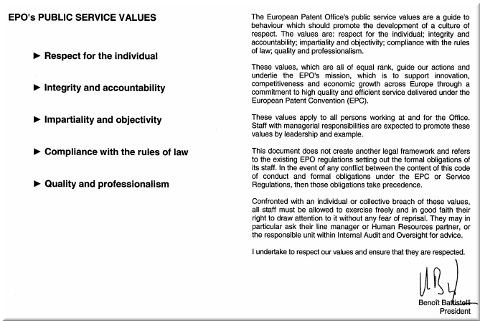
As a reminder, in the words of a reader, a lot of this relates to the union-busting activities we have been seeing since the end of 2015 (they truly intensified at that point but didn’t start then). Here is what Battistelli et al pushed through to staff:
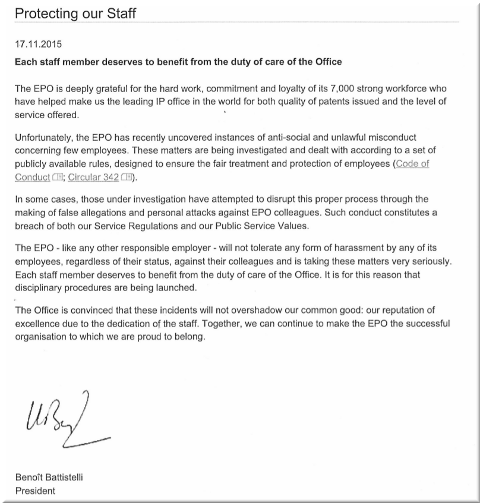
The above was a culmination of something that had been cooking for a while. Consider the full CoC:
Europaisches Patentamt
European Patent Office
Office européen des brevets
CODE OF CONDUCT
FOR THE EPO
EPO’s PUBLIC SERVICE VALUES
- Respect for the individual
- Integrity and accountability
- Impartiality and objectivity
- Compliance with the rules of law
- Quality and professionalism
The European Patent Office’s public service values are a guide to behaviour which should promote the development of a culture of respect. The values are: respect for the individual; integrity and accountability; impartiality and objectivity; compliance with the rules of law; quality and professionalism.
These values, which are all of equal rank, guide our actions and underlie the EPO’s mission, which is to support innovation, competitiveness and economic growth across Europe through a commitment to high quality and efficient service delivered under the European Patent Convention (EPC).
These values apply to all persons working at and for the Office. Staff with managerial responsibilities are expected to promote these values by leadership and example.
This document does not create another legal framework and refers to the existing EPO regulations setting out the formal obligations of its staff. In the event of any conflict between the content of this code of conduct and formal obligations under the EPC or Service Regulations, then those obligations take precedence.
Confronted with an individual or collective breach of these values, all staff must be allowed to exercise freely and in good faith their right to draw attention to it without any fear of reprisal. They may in particular ask their line manager or Human Resources partner, or the responsible unit within Internal Audit and Oversight for advice. I undertake to respect our values and ensure that they are respected.
Benoît Battistelli
President
RESPECT FOR THE INDIVIDUAL
The services provided by the Office are the result of the work done by qualified and motivated staff members. The Office therefore recognises the individual value of each and every employee. Mutual respect, dignity, respect for human rights, nondiscrimination and the promotion of diversity are our guiding principles.
Our keywords
• DIGNITY
• NON-DISCRIMINATION
• TOLERANCE
• TRUST AND RELIABILITY
• LISTENING AND UNDERSTANDING
• POLITENESS
• OPENNESS
• DIALOGUE
• HEALTH
• SAFETY
Our approach
We share the international community’s commitment to respect human rights.
We strive to create a working environment marked by mutual respect.
Mutual respect, trust and the ability to listen are indispensable elements in our professional relations. Each individual’s abilities and talents deserve to be acknowledged.
We take the necessary steps to provide a safe and healthy working environment.
We seek to promote diversity and equal opportunities among employees.
We are committed to not allowing situations to arise which could be prejudicial to the dignity of our colleagues. We make every effort to prevent any form of discrimination or harassment.
INTEGRITY AND ACCOUNTABILITY
Integrity is an inalienable criterion for our professional conduct. It implies acting with responsibility, accountability, loyalty, discretion and common sense. We resist all forms of corruption.
Our keywords
• HONESTY
• LOYALTY
• FAIRNESS
• CONFIDENTIALITY
• EXAMPLE
Our approach
We act with honesty, responsibility and discretion.
We act with loyalty and solely in the interest of the Office. We perform our tasks under the authority of the President of the Office, except for the specific responsibilities or functions expressly laid down in the EPC or Service Regulations.
We respect the scope of our responsibilities and of the tasks entrusted to us. When delegating tasks, we remain accountable for their execution and results, and therefore managers exercise adequate supervision and control.
We respect the confidentiality of information: we do not disclose confidential information received in the course of our work to unauthorised persons, nor use it for our own benefit or to the detriment of the Office.
Our duty to do our work to the best of our abilities also implies an obligation to share with our colleagues the information necessary to perform their own duties.
We are committed to combating all types of fraud.
We are careful in our external communications and respect our duties of tact and discretion about the Office. In particular, we refrain from making any statement that could be detrimental to it.
IMPARTIALITY AND OBJECTIVITY
The Office and its staff must remain independent of all governments, authorities, organisations or persons outside the Organisation. Our conduct must be impartial and reflect that independence. We tackle situations which could impair our objectivity.
Our keywords
• INDEPENDENCE
• NEUTRALITY
• EQUAL TREATMENT
• IMMUNITY
Our approach
We seek to ensure that nothing which occurs under our responsibility is or could appear to be a direct or indirect act of preferential support for a political, economic, ideological or religious group.
We refrain from doing or saying anything that might call our impartiality and objectivity into question.
Our actions when taking decisions or leading projects are reasoned.
We need to be impartial and objective. We are aware of the risk of potential conflicts of interest, whether actual or apparent. Where possible, we avoid them; where not, we disclose and manage them.
Gifts or other favours might compromise our professional impartiality. Therefore we do not solicit any. And, without the President’s permission, we do not accept any either.
COMPLIANCE WITH THE RULES OF LAW
The Office has its own legal system, which must be respected.
The Office and its staff must also respect the applicable national laws of the country they are in and must meet their legal and financial obligations.
Our keywords
• LEGALITY
• JUSTICE
• RIGHTS AND OBLIGATIONS
Our approach
We respect both the letter and spirit of the Office’s rules and regulations.
We apply these rules and regulations fairly and in good faith.
We act with professionalism and a sense of social responsibility in observing the applicable laws, and respecting customs and traditions of the countries in which we work, contributing responsibly to the welfare of society.
Our privileges and immunities do not prevent us from complying with our obligations under applicable national laws.
QUALITY AND PROFESSIONALISM
The way each of us does our job is reflected in the Office’s overall performance. Our commitment to high quality and efficient public service is a contribution to innovation, competitiveness and economic growth in Europe.
Our keywords
• INNOVATION
• COMPETENCE
• PROFESSIONALISM
• TRAINING
• EXCELLENCE
• EFFICIENCY
Our approach
We give of our best to achieve our professional goals and to offer an efficient public service.
We work with colleagues in a spirit of teamwork and co-operation.
We manage the Office’s resources appropriately and efficiently, in line with the principles of economy and sound financial management.
We strive to maintain, adapt and develop skills within the Office. With the aim of ensuring sustainability, we act in a strategic and long-term perspective, not in our own immediate interests.
We do our best to reach highest international standards and best practice.
The above makes widely available what should have been publicly available all along. It helps accountability (for management, not only those who are managed by abusive management).
Later this week we are going to show how Battistelli essentially engineered the sacking of people whom he viewed as obstruction for his (and his corporate bosses’) agenda. Stay tuned for more. █
Permalink
 Send this to a friend
Send this to a friend
Posted in America, Asia, Patents at 2:48 pm by Dr. Roy Schestowitz

Summary: How software patents can retard innovation in the autonomous cars space and why it’s the far east (Asia) that’s likely to exploit this obsession with patents
NOW that David Kappos lobbies for software patents after his USPTO career and Battistelli threatens to bring software patents to Europe through EPO/UPC, let’s consider what’s at stake and whether society should tolerate it. People have been driving for many years; there’s nothing novel about it.
Decades ago Martin Goetz had CAFC introduce software patents in the US (the first software patent ever to be granted relates to this) and right now a blog of software patents proponents writes about patents on autonomous cars.
“Media and Sonar Systems have the least number of patent filings with only 396 and 597 patents/patent applications respectively.”
–Rahul VijhThis matters to me personally as I previously developed an Android app for computer vision on the dashboard (my research field at one time though I usually dealt with medical/biology). I did wonder how many software patents existed in this domain in the US, but I never bothered checking (it’s infeasible). According to the blog: “As with any new emerging technology, focus also shifts to patents and patent ownership trends on that technology. Research shows that technologies such as Adaptive Cruise Control and Anti-Collision Systems have the highest number of patents/patent applications filings, followed by Braking Control Mechanism and Communication Systems. Media and Sonar Systems have the least number of patent filings with only 396 and 597 patents/patent applications respectively.”
That’s a lot of patents. Many are on software. Tesla, which more or less gave up on patents in this domain, gets mentioned later: “Despite the small portfolio size, Tesla oft shares spotlight with Google – and has announced that the new Model 3 cars shipping in 2017 will be able to run in ‘Autopilot’ mode at least on freeways and to “Summon” itself out of its parking spot. But that’s not just why Tesla is dangerous for competition. Tesla’s product seems to be the most advanced commercially-viable implementation of autonomous car technology – seeing how the Model 3 is only expected to cost $35,000, which means the heat is really on for the other larger traditional automobile players (and also on Google and Apple) to commercialize their own autonomous car technology, and make it accessible to regular consumers, before Tesla takes the road from beneath their wheels.”
“That’s a lot of patents. Many are on software.”Looking at today’s news alone, one finds that the US is falling behind in this area, in spite (or maybe because) of patents. Too many patents on this domain (driving as ‘innovation’) hamper progress and new articles indicate that it’s a growing industry that has moved to the far east [1, 2, 3, 4, 5, 6].
Consider for a moment the fact that many of the methods described in such patents have nothing to do with mechanics and everything to do with computer programs (that’s just what autonomy is about). These are software patents on emulation of whatever drivers have been doing for about a century. What’s next? A flood of “on a car” patents? Like “over the Internet” or “on a computer” patents? █
Permalink
 Send this to a friend
Send this to a friend
04.09.16
Posted in Apple, Microsoft, Patents at 11:21 pm by Dr. Roy Schestowitz
Still sticking its dirty fingers in many patent pies

Summary: An all-encompassing (based on our admittedly limited breadth or scope of research) roundup of patent news pertaining to software in the US
THIS article is a summary of recent USPTO news. It’s as comprehensive as possible and it focuses, as usual, on software patents. Those are just most relevant to us.
“Anyone can probably see that USPTO greed (for both power and money) is going way too far.”
Quality Control Out the Window
Patently-O, a decent source of information on the subject of patents (albeit a little subjective at times, which is understandable given the audience it reaches), looked at recent changes related to infringement and invalidity of patents. The latter article said that “the district court rejected the plea for vacatur — finding that the PTO decision does not “displace a district court judgment” and that it would be “against the public interest” to allow a patentee to overcome an invalidity judgment simply by “amending its invalid claims.” [...] What is unclear here is the level of claim & issue preclusion that will apply going forward when Cardpool asserts the patent against some third party.”
“What we deal with here is a patent troll that claims it ‘owns’ scanning activity.”Watch what the USPTO is up to. Basically, as usual, having seen the courts invalidating many of its bogus patents (minimal quality control is to blame here), it now looks to bolster/improve its business by making a mockery of the course of justice. What is this, a third world country? Anyone can probably see that USPTO greed (for both power and money) is going way too far. The USPTO is very plaintiff-friendly because plaintiffs are its ‘clients’ (applicants). The USPTO must be kept out of the legal process altogether. The same goes for the EPO (increasingly abusive in that regard under Battistelli’s regime). Some people are now bombarding the patent system with more automated tools/robots (like DMCA requests that are bogus and served by algorithms, or trading activity in stock markets, also using algorithms). See this new press release about a “Proprietary Patent Application Software”. These help exhaust, fool, mislead examiners. They even say “proprietary” as if it’s some kind of marketing term. “Every bloody unit will be using proprietary software components jealously guarded by patents,” said this article from 2 days ago.
“Patently-O noted that in some particular cases even antitrust laws creep in.”In other new blog posts from Patently-O the MPHJ patent troll is revisited (it can come to Europe with UPC hooks perhaps, suing everyone who uses a scanner if all goes as Battistelli foresees). “HP challenged claim 13 on both obviousness and anticipation grounds,” noted Patently-O, after MPHJ had already sued so many people who habitually use a scanner at a business (and often retrieved ‘protection money’ without as much as a legal challenge). What we deal with here is a patent troll that claims it ‘owns’ scanning activity. It’s really about as bad as it sounds. No exaggeration is needed, hence it resulted in plenty of press coverage over the years.
Institutional Corruption in the US Patent System
Another new Patently-O article deals with a patent “case involving both plaintiffs and defendants presenting false expert testimony.”
“When a nation’s patent system mostly serves to protect one’s giant (and often taxpayers-funded) monopoly the perception of corruption will inevitably increase.”Yes, nice to have ‘justice’… whoever has the deeper pockets (or less to lose) tends to win. Who benefits from all this chaos? Patently-O noted that in some particular cases even antitrust laws creep in. To quote this new post about GlaxoSmithKline (GSK): “The question in the case, now pending before the U.S. Supreme Court is whether that license structure can raise a plausible antitrust claim under F.T.C. v. Actavis, Inc., 133 S. Ct. 2223 (2013).”
When a nation’s patent system mostly serves to protect one’s giant (and often taxpayers-funded) monopoly the perception of corruption will inevitably increase. Who’s being served here? The public that will consequently be overcharged and have few (or none at all) alternatives? Going back to the false testimony, Patently-O wrote: “On cross-examination, Rembrand’s technical expert witness Dr. Thomas Beebe “drastically” changed his testimony regarding his methodology for testing whether the accused contact lenses were “soft.” After being called-out by the defense’s expert Dr. Christopher Bielawski, a jury found no-infringement. Post-trial, the district court doubled-down by also granting J&Js motion for JMOL of non-infringement. Bielawski’s testimony may have been particularly damaging – with his statement: “You should not trust Dr. Beebe, and you should throw out his testimony, not in part, but in whole. You should not trust Dr. Beebe.””
“A patent system of secrecy defeats the very purpose (original goal) of the patent system.”Judging any case at all based on written/oral testimony is dangerous and misguided. It’s like using the words of cops or some errand bystanders as evidence in criminal trials. Any such ‘evidence’ is the weakest form of evidence because there is no way to ascertain/verify claims. Moreover, people are often corruptible and when there’s much at stake in a trial (not just prison but a lot of money) there’s plenty of room for abuse, such as bribery. Remember those infamous cases of Apple with jury foreman Hogan? Probably trial misconduct. Don’t forget Court of Appeals for the Federal Circuit (CAFC) corruption either.
Pressing on, the EFF celebrates progress in a patent case it intervened in one year ago. It says it “has put significant time and effort into getting this one document in one case unsealed. Unfortunately, it is just one of countless documents that are routinely sealed without good reason in patent cases around the country. Just last week we asked the court in a different patent case to unseal documents that almost surely should not have been completely hidden from public view.”
“It is worth adding that while the number of lawsuits did provably decline it does not tell the full story for more than a single reason and we should generally take with great degree of caution any conclusions that accompany this, e.g. that things are improving on their own, hence no intervention is needed at all.”
Overlooking Patent Trolls in Post-Alice Era
A patent system of secrecy defeats the very purpose (original goal) of the patent system. This kind of secrecy gave rise to shady, secretive operations such as Intellectual Ventures, which boasts thousands of shell companies. This whole kind of system (unaccountable and unregulated) is ripe for abuse by trolls.
“US patent case filing in district courts dropped in the first quarter,” MIP wrote, “down 39% on the fourth quarter and 34% on the first quarter last year, according to Unified Patents. An analysis of Eastern District of Texas filing reveals a disproportionately large drop in the district” (that’s the summary of a paywalled article from MIP).
This echoes several other Web sites which reference the same data and conclude that it’s all about trolls and the Eastern District of Texas. This is a somewhat simplistic view because in reality, as we pointed out the day before yesterday, there are also settlements outside the courts and it might be worth looking at what proportion among these patent lawsuits involved some kind of software patents, hence identifying a correlation between scale of litigation and patent scope rather than lawsuit venue, a plaintiff’s business model and so on. In reality, some of these surveys are politically or commercially motivated, or are set up by academics (or lobbyists) to suit a particular narrative and then push for some particular kind of reform (e.g. a ‘reform’ for more certainty around software patents in the US — something which Kappos lobbies for with money from patent aggressors such as IBM, Microsoft, and now Apple as well).
It is worth adding that while the number of lawsuits did provably decline it does not tell the full story for more than a single reason and we should generally take with great degree of caution any conclusions that accompany this, e.g. that things are improving on their own, hence no intervention is needed at all.
As we found out only earlier this year, one verdict in favour of a patent troll such as VirnetX can cost a great deal of money. VirnetX, according to CCIA’s Matt Levy, now denies that it’s a patent troll, which is of course somewhat laughable a thing to do. “A patent troll is,” Levy explains, “essentially, a company that makes its money by suing companies that it claims are using patents that it has acquired. (For comparison, the FTC said that “The business model of [patent assertion entities] focuses on purchasing and asserting patents against manufacturers already using the technology, rather than developing and transferring technology.” Brian Kahin describes patent trolls as companies whose business is being infringed and whose product is litigation.)”
If one asks IAM ‘magazine’, no such thing even exists and it hardly surprises us that several trolls are paying IAM.
Speaking of payments, Oracle had paid Florian Müller, so it’s not too shocking that he took Oracle’s side in his latest article about Oracle’s war on Android. Müller spent a lot of his life campaigning against software patents and we hope this will precede the desire to make cash with so-called ‘consulting’ contracts.
“On March 22, 2016,” said this new article, the U.S. District Court for the District of Delaware issued a Memorandum Opinion in a case captioned Treehouse Avatar LLC v. Valve Corp., in which software patent claims survived a patent eligibility challenge.”
Alice does not always kill software patents, but it does most of the time. Another new article speaks of the Mayo/Alice Rule (both SCOTUS decisions). Now that there’s no Scalia at SCOTUS some people wonder what will happen regarding patent cases. Will the “T” word (trolls) come up again in transcripts or even formal rulings/determinations? Those who argue against reform regarding trolls are quoted in this new article which says: “Jessica Sebeok, associate vice president for policy at the Association of American Universities, believes universities will suffer unintended consequences if President Barack Obama succeeds in making it tougher for patent holders to defend their intellectual property.”
“And some people keep telling the world that Microsoft has changed or that there’s a ‘new’, gentler Microsoft…”Well, universities that essentially behave like patent trolls or feed trolls with their patents (we gave many examples here before) might suffer. And if so, that’s a good thing. The article later says: “Business coalition United for Patent Reform – whose membership includes influential allies of the Obama Administration like Google, Amazon and General Motors – and other supporters of HR 9 seek to stop patent trolling by making it riskier to file patent infringement suits and imposing additional costs of plaintiffs, but AAU argues this would put undue pressure on legitimate patent holders.”
Microsoft Licensing Still an Active Patent Troll
In the above, neither side speaks about patent scope. To them it’s just a so-called ‘Turf War’ between producing and non-producing (e.g. universities) entities. A company like Microsoft is both because while one company produces things another one, called “Microsoft Licensing”, is effectively a patent troll and based on this new page, Microsoft not only funds front groups for software patents and conferences that promote software patents, it now also puts its finger in the “2016 Hispanic National Bar Association/Microsoft IP Law Institute” pie, where Microsoft is the sole program supporter.
And some people keep telling the world that Microsoft has changed or that there’s a ‘new’, gentler Microsoft… █
‘“Other than Bill Gates, I don’t know of any high tech CEO that sits down to review the company’s IP portfolio” —Marshall Phelps
Permalink
 Send this to a friend
Send this to a friend
Posted in Debian, Deception, GNU/Linux, IBM, Law, Microsoft, Patents at 2:50 pm by Dr. Roy Schestowitz
English/Original
Article as ODF
Publicado en Debian, Decepción, GNU/Linux, IBM, Law, Microsoft, Patentes at 6:23 pm por el Dr. Roy Schestowitz
Una familia grande y felizcon montón de dinero en circulación y una agend pro-patentes de software
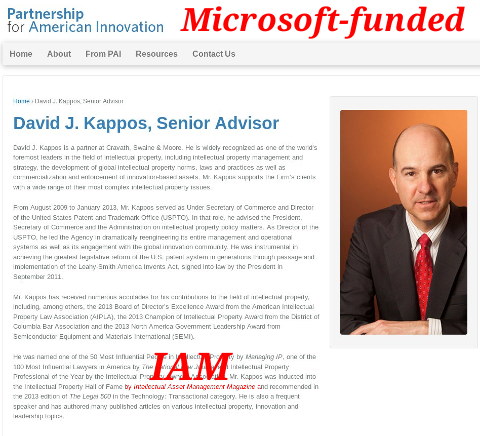
Sumario: Los últimos ejemplos de inéquivocosempujes por las patentes de software bajo el disfraz de ‘reportajes’ (pobre farsa) o ‘reforma’ de patentes (nada que ver con reforma), courtesía de IAM ‘magazine’ y David Kappos, respectivamente
LA cálidad de patentes en la USPTO bajo el mando de David Kappos ha sido pobre y en decadencia. Esto aparentemente fue su objetivo o (predictivamente) consequencia de la estrategia. Deja a los Estados Unidos en un estado de desórden total, donde un montón de compañías ´start-ups´ tosen ‘dinero por protección’ o se van a la quiebra. No sólo trolles de patentes están causando estos estragos pero también grandes agresores de patentes, como Microsoft y IBM. Imaginen lo que significaría esta clase de caos para la India, donde un montón de software es desarrollado y el presupuesto de las firmas locales es ajustado (contratar abogados en otro país es oneroso).
“No sólotrolles de patentes están causando estos estragos pero también grandes agresores de patentes, como Microsofty IBM.”
Haciéndo balance de la última propaganda del ‘magazine’ IAM, Techrights no puede dejar de regañar y el ridículizar a este llamado ‘magazine’ (parece mas un pamfleto de cabildeo). No es incluso un magazine, es Kool-Aid en forma de papel y un sitio de pago web (para mantener sólo el coro, voces disentivas no son permitidas). Aquí esta el lavado de cerebro de IAM acerca de ‘calidad’ de patentes hoy (el número de patetentes otorgadas creciendo al doble en sólo pocos años es una evidente indicación de su baja cálidad) e incluso peor lavada de cerebro es aquella que engañosamente representa el punto de vista de los Hindues, compuesto por un Anglo-Saxon quien es empleado para escribir tales callos. No Hindú es incluso citado en este artículo, excepto una firma de leyes (!obviamente no parcialidad!).
Incluso después de que Alice, desafíe las patentes de software en su país de origen, IAM sigue pataleándo por las patentes de software. IAM tiene su base en Londres, lo que hace que sea aún más indignante, hasta que uno comprueba que los fondos del IAM en realidad provienen de …
“Techrightsno puede dejar de regañar y el ridículizara este llamado ‘magazine’ (parece mas un pamfleto de cabildeo). No es incluso un magazine, es Kool-Aid en forma de papely un sitio de pago web (para mantener sólo el coro, voces disentivas no son permitidas).”
Robert R. Sachs del Bilski Blog (ástutamente nombrado como el famoso caso Bilski) esta preparando un reporte (y una serie de artículos derivados de el) acerca del porque las patentes de software son simplemente procesos mentales, por lo tanto abstráctas. En muchos aspectos, las patentes de software son un gran engaño, que explotan la incomprensión de la gente de cómo funciona realmente el software (no es difícil estafar o embaucar a los jueces de patentes que nunca escribierón una sola línea de código).
Temprano hoy confronté al editor en jefe de IAM, quien esta en negación de trolles (todavía pretende que ese problema exista, al igual que las personas que niegan el calentamiento global provocado por el hombre o el cambio climático). Este editor y sus chicos (la única mujer que hay administrativo) no están reportando. Están presionando por las patentes de software en la India hoy en día, con el uso de la distorsión de los hechos y mentiras. La culpa es de IAM por hacer esto. Como dije el día de hoy, en respuesta al editor: “Mientras ustedes hacen lavado de reputación de los trolles de patentes y de las patentes de software, mientras al mismo tiempo ellos son los que les pagan, esas son noticias falsas. PR “.
“Ellos están presionando por las patentes de software en la India hoy en día, con el uso de la distorsión de los hechos y mentiras .”
Es extremandamente importante sacar a la luz de quien IAM realmente es y quienes lo están financiando (y el porque).
Como dije el día de hoy, IAM “sigue demostrando que no es un verdadero periódico / revista, pero sólo esta cabildeando por dinero mientras pretendoe estar reportando. Asqueroso.”
IAM está lleno de maximálistas de patentes (miren de donde proviene el autor) quien quiere más patentes en más lugars, más dominios, más compañías, y así sucesivamente. IAM es financiado por aquellos intereses. ¿Qué dice esto de IAM? Es como una revista acerca de energía que es financiada por petroleras y compañías de carbon, en orden de suprimir información acerca de formas altenativas de energía. Por lo menos parcialismo por omisión. Este ‘magazine’ IAM conectado con villanos y la EPO ahora se atreve avergonzar a la India por su muy táctica decisión de bloquear las patentes de software, de la misma manera que lo hizo con Alemania por no hacer lo suficiénte (para disgusto del editor) para promover abiértamente a la UPC, la cual incidentalmente pagó a IAM para promover(incluso por la firma PR de la EPO). No se necesita ser un genio para ver lo que aquí sucede, quien paga, y cui bono etc. IAM dedicó su último número al troll de patentes más grande del mundo [EN|ES] — un asunto que fue incluído en este artículo, cuya sóla premisa (y titular) es una gran mentira. El título dice: “La actitud fuerte de la India contra las patentes de software podría obstaculizar los planes de impulsar sus “start-ups” digitales (no jodan!). Lo único y correctamente que la decisión India está obstaculizando es la criminal extorsión y cobro de cupos por supuesta protección de parte de los trolles de patentes y las grandes corporaciónes detrás de ellos, lease la Sagrada Familia: Microsoft, IBM, Apple y otros.
“Cada vez es más importante sacar a la luz lo que realmente IAM es y quienes lo están finánciando (y el porque).”
En realidad, lo opuesto es cierto, ya que las patentes de software obstaculizarían las ´start-ups´ de la India. Pregúntelo a estas nuevas empresas y ellas se lo dirán. Solicitar a Microsoft o IBM (o sus abogados de patentes en la India) y ellos hablarán ‘a favor’ de nuevas empresas sólo un montón de mentiras. Pregunte a los grupos de presión de las grandes empresas y sus abogados de patentes (como los que pagan IAM) y ellos también le dirá un montón de mentiras. Es el mismo escenario que vimos en New Zealand y en Europe, donde Microsoft paga cabilderos para supuestametne representar PYMEs y actualmente dice lo opuesto a o que las PYMEs Europeas piensan creen y necesitan. IAM ahora demuestra que no es mejor que esos cabilderos. La diferencia es la manera en que se carácterizan a sí mismos.
Indian startups necesitan código no patentes, las que están fuera de su alcanze de todas maneras, no importa el costo del litigio. IAM escribió: “Me parece que esto podría causar grandes problemas para las empresas de nueva creación digitales que el gobierno tiene tanto interés en apoyar. Muchos de ellos tendrán las innovaciones relacionadas con la informática en el corazón de sus modelos de negocio; si llega a ser mucho más difícil para ellos obtener protección de patentes sobre estos, entonces las razones para que consideren su reubicación fuera de la India podría llegar a ser aún más convincente.”
“Indian startups necesitan código no patentes, las que están fuera de su alcanze de todas maneras, no importa el costo del litigio.”
Esto son tonterías. ¿Dónde esta la evidencia que sin patentes de software aquellas start-ups se mudarían de la India y dado que el mercado de software es internacional (definivamente no local), ¿Qué diferencia la relocación tendría? Podría hacer una diferencia para corporaciones multinacionales como IBM or Microsoft, no duda acerca de eso…
Hablando de Microsoft, anoche descubrimos (no sorprendente) que Microsoft está poniéndo dinero en la mesa de Debian (conferencia). Se convierte en — gasp — un financista. Si, es E.E.E., pero ¿Entiénde Debian eso? Como notamos hace unos dias y el último fin de semana, Microsoft todavía financia conferencias de maximálistas de patetnes (con Microsoft financiados cablideros quienes promueven las patentes de software), donde pueda poner más adentro de la EPO su influencia (su socio criminal) y políticos Europeos. ¿Puede Microsoft ser confíado cuando continúa extorsiónando y chantajeando a fabricantes de aparatos basados en Debian usando patentes de software? Eso es una pregunta retórica.
“¿Puede Microsoft ser confíado cuando continúa extorsiónando y chantajeando a fabricantes de aparatos basados en Debian usando patentes de software?”
Incidentalmente habiéndo mencionado a David Kappos temprano, él también está actuando más como un grupo de presión (oficial convertido en cabildero de una manera clásica de convertir influencia en dinero), financiado por Microsoft y otras empresas con el fin de promover las patentes de software. Recuérden que Horacio Gutierrez y sus compañeros de Microsoft una vez (o más de una vez) pagarón a Florian Müller para hacer lo mismo. Aquí esta un artículo reciénte que un lector nos envió anoche.Se deja de mencionar el papel especial de Kappos allí. Sólo dice que “Apple está tomando un papel más importante en el impulso a la reforma de patentes en los Estados Unidos asociándose con IBM, Microsoft y otras empresas como parte de la Asociación Americana para la Innovación. El objetivo de la organización es para presionar al gobierno federal a adoptar los cambios que quiere mejorar sistema de patentes del país.
No, sólo quiere promover las patentes de software. Cuando Microsoft dice “reforma” de patentes significa cabildeo por las patentes de software (al igual que Apple e IBM). Ellos secuestran la palabra reforma y el jefe de su principal grupo de presión en el PAI es el mismo David Kappos.”
“¿Microsoft está ahora en el mismo grupo liderado por Kappos que promueve las patentes de software.”
“Por cierto,” nos dijo un lector, “nos hemos estado preguntando aquí acerca de por qué Microsoft es tá tan tranquilo y no ataca las legislaciones de implementación dee software libre. Nos dimos cuenta de que deben estar trabajando en algo con lo que se deshacerán de ambos. Escarbándo un poco, pueda ser que ellos esten confidentes que la TTIP, TISA, y CETA prohibirán FOSS. No hay cubrimiénto de ello en la prensa. Así mismo, Veo que me he subestimado la importancia de Wikileaks, así como los motivos de Microsoft y sus peones del gobierno de aplastarla. Por lo que yo sé, TISA o TTIP también está impulsando las patentes de software, pero he leído casi nada todavía y estoy a punto de comenzar.”
Microsoft esta en le grupo liderado por Kappos que promueve las patentes de software. Como nuestro lector lo pone, “reforma resulta ser otra de sus palabras comadreja”
Lo mismo va por “amando” a Linux. Cuidado, Debian. Ya estás quebrado y fragmenta do debido a systemd. ¿Ahora dejas que un matón de patentes entre a tus conferencias? ¿Distribuiras botones que digan “Microsoft ama a Linux” a los asistentes, como es usual? Perfectamente va con el último perfil E.E.E..
“He matado al menos dos conferencias de Mac. [...] Mediante la inyección de contenido de Microsoft en la conferencia, la conferencia cerró. El tipo que lo dirigió, dijo, ¿por qué estoy haciendo esto? “
Jefe Evangelista de Microsoft
Permalink
 Send this to a friend
Send this to a friend
Posted in Europe, Patents at 2:45 pm by Dr. Roy Schestowitz
English/Original
Article as ODF
Publicado en Europa, Patentes at 6:57 pm por el Dr. Roy Schestowitz
Snap!
Sumario: La libreta (u hoja) de Battistelli de acuerdo al oficial Códigode Conductaen la Oficina Europea de Patentes (EPO)
El Presidente de la EPO, con sus crecientes problemas con Brumme and Hardon está fallándo su propio CoC (Código de Conducat)y no pudimos evitar hacer un post crítico, el que muestra, punto por punto como Battistelli falla su propio CoC. Consideren las siguientes 2 páginas (en una sóla imagen) del CoC:
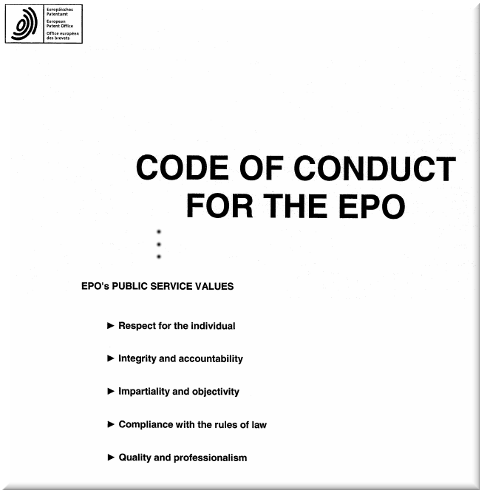
Actuálmente es muy fácil ver lo que aquí esta mal. Battistelli ha sido un niño muy traviesoporque (tomado en una base punto por punto):
¿Porqué Battistelli no ha sido despedido hasta ahora? Una ‘prohibición de la casa’ paraBattistelli y su innecesaria y matona guarda pretorianatiene mucho atraso. Tal movimiento devolvería el respeto a muchos individuos, devolver algo de integridad, dar la impresión de acountabilidad para todos, parecería imparcial para los trabajadores, que probablemente obedecen las leyes externas e internasparecería algo profesional dado todo lo que Battistelli ha estado haciendo hasta ahora.
Tenemos mucho más viniéndo este fin de semana. Sintonicenos.
Permalink
 Send this to a friend
Send this to a friend
Posted in Europe, Patents at 3:24 am by Dr. Roy Schestowitz
English/Original
Article as ODF
Posted in Europa, Patentes at 5:07 pm por el Dr. Roy Schestowitz
Hay muchas bien documentadas técnicas para suprimir huelgas, incluyendouniones amarillas como la FFPE-EPO
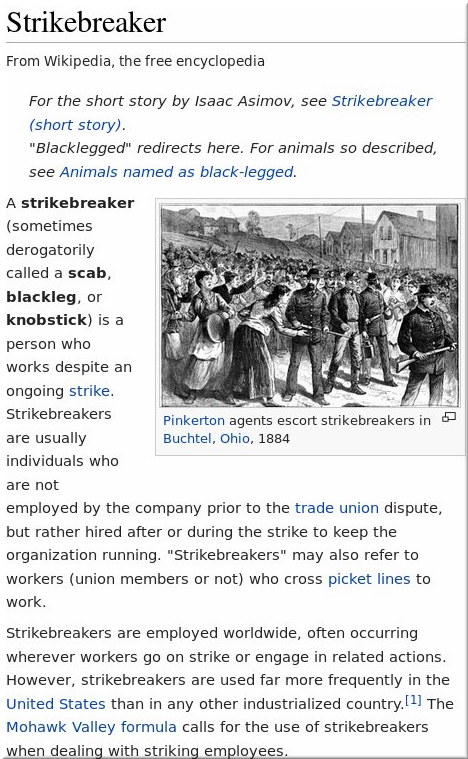
Fuente: Esquirol
Sumario: Figuras oficiales de la Oficina Europea de Patentes (EPO) no dicen la verdad acerca de la extensión de disturbios en la Oficina, como un lector nos explicó temprano hoy
LA Oficina Europea de Patentes tuvo su día más importante de huelga de ayer, pero sería mucho mayor si no fuera por las tácticas sucias de Battistelli y sus matones. Ya escribímos varios artículos sobre la supresión de la huelga (como la supresión del voto) y tácticas en adelante tenemos algo más de información sobre estas últimas tácticas. Los medios de comunicación en el Reino Unido escribierón al menos dos artículos sobre la huelga. El segundo que encontramos dice que 2,657 es el número exacto de trabajadores que fueron a la huelga. Para citar las partes relevantes: “Más de 2,600 empleados de la Oficina Europea de Patentes (EPO) se fueron de huelga ayer, en lo que una fuente de la EPO ha dicho que es el número más alto de huelguistas que la oficina ha visto. De acuerdo a la fuente, 2,078 empleados se fuero a la huelga el dia entero, mientras que 579 personas lo hicieron por medio dia. El número total alcanzó a 2,657 a traves de los cuatro sedes de la EPO. El 2014, 1,455 de los empleados se fueron a la huelga.”
Pero la pregunta verdadera ¿Cuántas personas quisieron irse de huelga pero no pudieron? “FYI,” un lector nos dijo, “Las figuras de la huelga de la EPO” no son toda la historia, aquí la tenemos por completo:
De acuerdo con las cifras oficiales de huelga, publicado por la EP HR Elodie Bergot el 8 de abril de 2016, un total de 2.657 empleados de EPO se registraron en huelga el 7 de abril (2.078 de un día completo, 579 de medio día). Esta parece ser la mayor participación oficial huelga jamás alcanzada por el personal de la EPO y corresponde a casi el 40% de los actualmente cerca de 6.800 empleados de EPO. Para comparar con la cifra más alta de paro oficial anterior (al menos desde el Sr. Battistelli se convirtió en presidente), hasta el 20 de noviembre de 2014, era 2.537. En ese momento, Florian Mueller informó que “el personal de 2,538 que representa el 36,7% de la población activa” participó en la huelga («http://www.fosspatents.com/2014/12/european-patent-office-examiners.html »).
Como de costumbre, los administradores, asistentes de gerente, en libertad condicional, empleados enfermos, que trabajan para la administración o de prestación de servicios de infraestructura personal no estaban autorizados a atacar. gestión de EPO utiliza una serie de trucos para dificultar a los empleados a ir a la huelga el 7 de abril, por ejemplo mediante la programación de reuniones para ese día y mediante la aplicación de sus habituales tácticas de intimidación. Y esta semana, (presumiblemente) varios cientos de miembros del personal en la rama en Rijswijk se encontraban en licencia debido a las vacaciones de la Escuela Británica en La Haya, y no tienen la oportunidad de ir a la huelga.
Teniendo en cuenta esto, más de la mitad de los que tenían la posibilidad de salir, estaban en huelga el 7 de abril de 2016. Jueves Esto demuestra que la motivación para ir a la huelga debe haber sido extremadamente alto esta vez.
Las cifras de huelga ejercerán presión sobre el presidente de EPO y sin duda tendrá una influencia en la reunión “Junta 28″ del Consejo de Administración prevista para la próxima semana.
¿Qué podemos deducir de esto? 1) muchos de los trabajadores de la EPO están tan molestos con la gerenciaque voluntariamente tomaron el riesgo de un corte de sus pagos. 2) la gerencia de la EPO continúa usando toda clase de trucos para evitar que los trabajadores ejerciten su derecho a la protesta/huelga (sin embargo hubo retribución/represalias). 3) Estiempo de sacar a Battistelli la próxima semanamientras la crisis sólo se profundiza y Battistelli no ha hecho virtualmente nada de lo que se le pidió hace tres semanas (para que desperdiciar otros dos meses).
Permalink
 Send this to a friend
Send this to a friend
Posted in Europe, Patents at 3:22 am by Dr. Roy Schestowitz
English/Original
Article as ODF
Publicado en Europe, Patentes at 6:06 am por el Dr. Roy Schestowitz
Sumario: Un resumen del último cubrimienteo acerca de la Unión de Empleados de la Oficina Europea de Patentes (SUEPO) y un poco acerca de la UPC, que hace a Europa más vulnerable de ser atacados por multinacionales agresores de patentes
LA EPO fué disruptida ayer. Casi vacía por la mitad. Esta mañana (hace apenas un par de horas) la SUEPO manifesto que una “carta de apoyo [fué envíada] por la EPSU Unión de Empleados de la Oficina Europea de Patentes” y que “La Federación Europea de Uniónes de Servicio Público (EPSU) representa más de 265 uniones. Esta semana su Secretario General Jan Willem Goudriaan envió una carta de solidardida a la SUEPO, cuyos miembros toman una acción de fuerza el 7 de Abril”
Aquí está la carta general. Fechada ayer:
Esta semana, el Secretario General Jan Willem Goudriaan envió una carta de solidaridada a la SUEPO (Staff Union of the European Patent Office (EPO), cuyos miembros toman una acción de fuerza el 7 de Abril.
La carta lee:
Queridos Colegas,
Le escribo para enviarle saludos solidarios de la EPSU para su acción el 7 de abril. Esperamos que la huelga se apoya sólidamente en todos los sitios de la Oficina Europea de Patentes. Hemos estado siguiendo la controversia y manteniendo informados a nuestros afiliados (www.epsu.org/a/11984)
Una victoria en la presente diferencia será importante no sólo para los empleados de EPO y los dos representantes sindicales que fueron despedidos en enero, pero tendrá implicaciones más amplias en términos de diálogo social y la negociación colectiva en las instituciones internacionales. Es un asunto de gran preocupación que la administración de EPO ha sido el argumento de que los derechos europeos e internacionales no se aplican a organismos como la EPO. Un resultado exitoso para SUEPO enviará un mensaje claro de que los empleados de las instituciones internacionales no serán negados estos derechos.
Sinceramente,
Jan Willem Goudriaan, EPSU General Secretary
En adición a los artículos relacionados con la huelga que hemos mencionado antes, hubo máscubrimiento de prensa de esta huelga. Battistelli está lejos ahora; ocupado conpervertir el sistema Británico con la UPC. Esta mañana encontramos a los abogados de patentes Británicos diciendo:: “El lanzamiénto de la Corte Unificada de Patentes (UPC) es inminente.”
“No es color de rosa para el plan de Battistelli o también llamadas ‘reformas’ lo que incluye tratar a los empleados como prisioneros, haciéndo muy fácil que las grandes corporaciónes (que NO SON Europeas) enjuicien a todos en Europa, y lo demás.”
Esas son completas mamadas. Profecíás que se cumplen a sí mismas,son un atentado para hacer la UPC una realidad al repetir constantemente que es inevitable, no importa una potencial salida del UK de la Unión European, un repaso mayor , y un saqueo de Battistelli, quién ha sido el cerebro de la UPC por lo menos 6 años.
Los exáminadores de la EPO no sólo jueces, el jurado (de apelaciónes) miembros etc. deberían reconocer que la UPC es un peligro para ellos (ambos como trabajadores y ciudadanos Europeos). Acerca de la huelga de la EPO, uno comentó (sólo un simple comentario fue publicado) sugiere deshacerce de la mitad de empleados (básicamente una purga de Battistelli). Para citar: “despedir a los feckers perezosos, a continuación, el resto puede realmente empezar a hacer algo de trabajo. Para ser honesto que estaríamos mejor sin ellos – acabaría en su lugar harmonizar las políticas de la Oficina Europea de Patentes “(armonización es un antiguo sinónimo de la UPC).”
No es color de rosa para el plan de Battistelli o también llamadas ‘reformas’ lo que incluye tratar a los empleados como prisioneros, haciéndo muy fácil que las grandes corporaciónes (que NO SON Europeas) enjuicien a todos en Europa, y lo demás. Se trata básicamente de un golpe de Estado corporativo, y Battistelli se ve a sí mismo como el maestro de ceremonias. !Qué tal concha!
Gurry, juzgando por este nuevo artículo, no ha renunciado todavía. Recuérden como el y Pinocho Battistelli compitiéron por el mismo trabajo (en la WIPO) y consideren como ambos terminaron atacándo sóplones e incluso causando suicidios. Aparentemente algunas muertes son necesarias por “bien mejor” para Republicanos como Battistelli (como en Iraq). Ellos saben bién lo que es bueno para los demás y no tolerán la minima oposición.
Permalink
 Send this to a friend
Send this to a friend
04.08.16
Posted in Europe, Patents at 6:57 pm by Dr. Roy Schestowitz
Snap!
Summary: The scorecard (or sheet) of Battistelli as per the official Code of Conduct at the European Patent Office (EPO)
The EPO‘s President, with his growing Brumme and Hardon issues, is breaking his own CoC (Code of Conduct) and we couldn’t help making a critical post which shows, point-by-point, how Battistelli breaks his CoC. Consider the following 2 pages (as one image) from the CoC:

It’s actually far too easy to see what’s wrong here. Battistelli has been a very naughty boy because (taken on a point-by-point basis):
Why hasn’t Battistelli been sacked yet? A ‘house ban’ for Battistelli and his unnecessary/frivolous bodyguards is well overdue. Such a move would respect many individuals, restore some integrity, give the impression of accountability for all, would seem impartial to most workers, probably comply with the rule of law and also seem professional enough given all that Battistelli has been doing as of late.
We have a lot more coming in the weekend, so stay tuned. █
Permalink
 Send this to a friend
Send this to a friend
« Previous Page — « Previous entries « Previous Page · Next Page » Next entries » — Next Page »

























 Content is available under CC-BY-SA
Content is available under CC-BY-SA